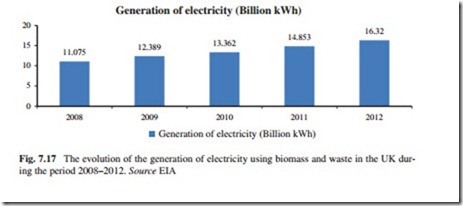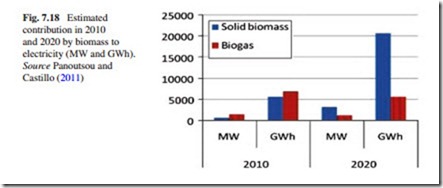United Kingdom (UK)
It is widely recognized that bioenergy has an important role to play if the UK is to meet its low-carbon objectives approved by the government by 2050. Excluding biomass from the energy mix would significantly increase the cost of decarbonizing the country’s energy system—an increase estimated by recent analysis at £ 44 billion. Undoubtedly, the use of biomass16 and waste as a transitional fuel to reduce carbon emissions from current coal power generation is an important decarbonization pathway. In addition, CHP generation offers more efficient use of the biomass resources and should be promoted where possible. As set out in the 2011 UK Renewable Energy Roadmap, bioenergy is also an important part of the government’s plan to meet the renewable objectives in 2020.
However, and despite all measures adopted by the government to increase the participation of biomass and waste in the country energy mix, the use of biomass is limited. Waste biomass is an underused resource, which could provide a significant contribution to UK renewable energy targets as well as reducing waste that is landfilled. Figures from 2009 estimate that 6 million tons of waste wood and 9 million tons of waste food are landfilled each year. Despite efforts to minimize this waste, it is clear that a supply of waste food and wood will exist. Currently, 6 TWh of heat and power is generated from biomass municipal solid waste collected by local authorities and about 18 TWh from landfill gas. If all the food and wood waste sent to landfill were used for energy, it would generate 42 TWh, or approximately 18 % of the UK renewable energy target (Panoutsou and Castillo (2011). UK NREAP figures for total biomass use in electricity are as follows:
• A 580 MW solid biomass installed electrical capacity or 5,500 GWh of generation;
• A 1,340 MW biogas installed electrical capacity or 6,830 GWh of generation.
The UK government has a responsibility to ensure that its energy policies only support the use of biomass for the generation of electricity in the right circum- stances. This strategy is based on a statement of four principles, which will act as a framework for future government policy on bioenergy. In summary, the four principles state that
• Policies that support bioenergy should deliver genuine carbon reductions that help meet UK carbon emissions objectives to 2050 and beyond;
• Support for bioenergy should make a cost-effective contribution to UK carbon
emission objectives in the context of overall energy goals;
• Support for bioenergy should aim to maximize the overall benefits and minimize costs (quantifiable and non-quantifiable) across the economy;
• At regular time intervals and when policies promote significant additional demand for bioenergy in the UK, beyond that envisaged by current use, policy makers should assess and respond to the impacts of this increased deployment in other areas, such as food security and biodiversity (UK Bioenergy Strategy 2012).
Currently, bioenergy accounts for 3 % of total primary energy consumption in the UK with the majority (65 %) been used in power generation. Its relative cost- effectiveness against other alternative renewable technologies makes it an attractive option for contributing toward the delivery of government renewables target, which requires to generate around 227 TWh of energy from renewable sources by 2020 (UK Bioenergy Strategy 2012).
Generation of Electricity Using Biomass and Waste
Bioenergy is one of the most versatile forms of low-carbon and renewable energy as it can contribute toward the energy generation across the energy spectrum of electricity, heat, and transport in the UK. In all three sectors, biomass can provide a continuous and constant flow of energy with less variability than some renew- able energy sources. In the specific electricity sector, bioenergy offers dispatchable generation with benefits for managing the wider electricity system.
The evolution of the generation of electricity using biomass and waste in the UK during the period 2008–2012 is shown in Fig. 7.17.
According to Fig. 7.17, the generation of electricity using biomass and waste in the UK during the period 2008–2012 increased 47.4 %. It is expected that despite of the limited participation of biomass and waste in the generation of electricity in the country, both types of energy sources will continue increasing during the coming years.
In the specific case of the electricity dedicated biomass, it shows mixed scores. The business case for dedicated biomass is reasonably strong. The indigenous
supply of wood or agriculture residue fuels is rather limited in the UK, and fuel supply chains have emerged in recent years, but are still immature and may always remain rather localized. Larger power plants require imported fuel, which is a challenge to obtain with secure long-term price stable contracts. Notwithstanding, several large power plants are being developed, and several may be granted plan- ning permission in the near future. There are also many facilities being planned at smaller scale, from 5 to 50 MW. Those at the smaller end are likely to be CHP sites, with heat supplied to local residents and commercial/industrial users. Large power plants may also supply some heat locally, but these are fundamentally power generation sites and their contribution to renewable heat will be limited.
In the specific case of the electrical energy from waste, it is a segment that could show considerable growth in coming years, although from very low levels. As noted above, there is considerable focus on reducing waste being disposed in landfill. An important factor has been the introduction of landfill tax, which is being steadily increased year on year. While the role of energy from waste is low in the “waste hierarchy,” being below reduction and recycling, there are nonetheless many opportunities. There are a considerable number of sites coming forward through the planning system (Panoutsou and Castillo 2011).
The estimated contribution of solid biomass and biogas in 2020 for electricity generation is shown in Fig. 7.18.

